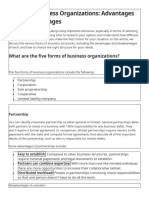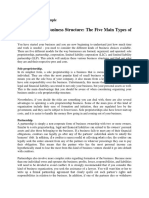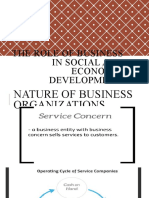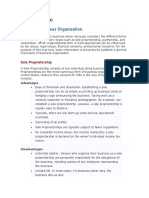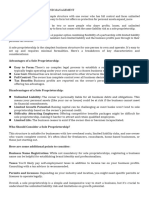0% found this document useful (0 votes)
246 views4 pagesThe 4 Major Business Organization Forms
The document discusses the 4 main types of business organization forms: sole proprietorship, partnership, corporation, and LLC. It provides an overview of the key characteristics of each form including advantages and disadvantages related to liability, taxes, costs, and flexibility. The types of business organization forms chosen will affect various legal and financial factors that can impact a company's future.
Uploaded by
vishant chopraCopyright
© © All Rights Reserved
We take content rights seriously. If you suspect this is your content, claim it here.
Available Formats
Download as DOCX, PDF, TXT or read online on Scribd
0% found this document useful (0 votes)
246 views4 pagesThe 4 Major Business Organization Forms
The document discusses the 4 main types of business organization forms: sole proprietorship, partnership, corporation, and LLC. It provides an overview of the key characteristics of each form including advantages and disadvantages related to liability, taxes, costs, and flexibility. The types of business organization forms chosen will affect various legal and financial factors that can impact a company's future.
Uploaded by
vishant chopraCopyright
© © All Rights Reserved
We take content rights seriously. If you suspect this is your content, claim it here.
Available Formats
Download as DOCX, PDF, TXT or read online on Scribd
/ 4



















